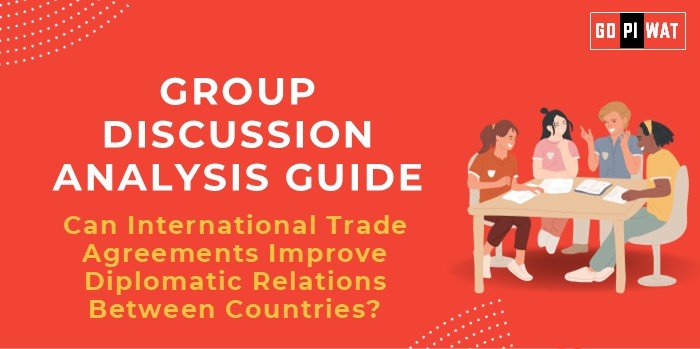📋 Group Discussion (GD) Analysis Guide
🌐 Can International Trade Agreements Improve Diplomatic Relations Between Countries?
📖 Introduction
Opening Context: International trade agreements are key tools for economic integration and globalization. They influence not just markets but also diplomatic ties, offering a platform for resolving conflicts, fostering collaboration, and strengthening interdependence between nations.
Topic Background: Trade agreements such as the North American Free Trade Agreement (NAFTA), the European Union (EU), and the Regional Comprehensive Economic Partnership (RCEP) demonstrate their role in bridging economies and ideologies. Recent disputes over tariffs, trade wars, and geopolitical tensions highlight the complexity of leveraging trade for diplomacy.
📊 Quick Facts and Key Statistics
- 🌍 Global Trade Volume (2023): $32 trillion, showcasing the interconnectivity of economies.
- 🌐 RCEP Membership: 15 countries, accounting for 30% of global GDP and population.
- 💼 US-China Trade (2022): Over $690 billion, despite ongoing tensions.
- 📈 EU Expansion Impact: Added 8% to the collective GDP of member states.
🌟 Stakeholders and Their Roles
- 🏛️ Governments: Negotiate, implement, and monitor trade policies and agreements.
- 🏢 Multinational Corporations (MNCs): Benefit from reduced barriers, advocate for fair regulations.
- 🌐 World Trade Organization (WTO): Mediates disputes and ensures compliance with international trade norms.
- 👥 Citizens: Benefit from economic growth but may face job shifts due to competition.
🏆 Achievements and Challenges
✨ Achievements
- ✅ Economic Growth: NAFTA increased trade among members by over 300% in 25 years.
- 🤝 Conflict Mitigation: Trade between India and China rose despite border tensions, reducing escalation risks.
- 🔗 Global Supply Chains: Agreements stabilize and optimize supply chains, benefiting global commerce.
⚠️ Challenges
- ⚔️ Trade Wars: US-China disputes over tariffs demonstrate vulnerabilities in trade relations.
- 📉 Unequal Benefits: Smaller economies may face challenges against larger, dominant players.
- 🌍 Geopolitical Risks: Agreements often exacerbate tensions when linked to political agendas.
📘 Global Comparisons:
– EU Model: Fostered peace and unity, particularly between historic rivals France and Germany.
– BREXIT: A cautionary tale of how trade agreements can both build and strain relationships.
– Case Studies:
– RCEP: Facilitated cooperation among nations with diverse political systems, including China and Australia.
– USMCA (Post-NAFTA): Improved mechanisms for labor disputes and environmental policies.
💬 Structured Arguments for Discussion
- ✅ Supporting Stance: “Trade agreements foster mutual dependence, reducing the likelihood of conflict.”
- ❌ Opposing Stance: “Trade deals can exacerbate inequalities and deepen geopolitical tensions.”
- ⚖️ Balanced Perspective: “While trade agreements enhance diplomacy, they require equitable frameworks to sustain long-term cooperation.”
💡 Effective Discussion Approaches
- 🌏 Opening Approaches:
- Data-driven: Highlight trade growth figures and their diplomatic implications.
- Case-based: Begin with examples like RCEP or the EU to illustrate real-world impacts.
- 🤔 Counter-Argument Handling:
- Cite WTO mediation successes to counter claims of inefficacy.
- Discuss mechanisms like dispute resolution clauses to address concerns over trade wars.
🔍 Strategic Analysis (SWOT)
- 💪 Strengths: Enhances economic interdependence, boosts cooperation in other domains.
- ⚖️ Weaknesses: Risks of exploitation by dominant nations, trade wars.
- 📈 Opportunities: Post-pandemic trade recovery, green trade agreements.
- ⚠️ Threats: Rising protectionism, political misalignment.
🎓 Connecting with B-School Applications
- 🌍 Real-World Applications: Topics for operations projects (e.g., global supply chain impact), finance projects (tariff economics).
- 💬 Sample Questions:
- “How do trade agreements like RCEP impact small economies?”
- “What role does the WTO play in balancing trade and diplomacy?”
- 💡 Insights:
- Understand the interplay between policy and market trends for internships or research.
- Analyze the role of trade agreements in managing global business risks.


